Gulf of Mexico Oil Spill That Has Lasted 14 Years Will Soon Be the Worst in History
Following the toppling of an oil production platform owned by Taylor Energy in 2004, multiple uncapped oil wells have spewed millions of gallons of the material into the ocean, and in due time, the disaster will likely become the worst in history, the Washington Post revealed in a report published on Monday.
Every day over the last 14 years, nearly 12,000 to 30,000 gallons of oil have spilled out into the Gulf of Mexico after the powerful winds of Hurricane Ivan knocked over a Taylor Energy drilling platform located 12 miles off the coast of Louisiana. A mudslide caused by the storm ended up shifting a large part of the ocean floor and made detecting the leaking wells difficult. As a result, many of them have been left unplugged. According to the AP, the heads of the wells are located more than 400 feet below water and are buried under 60 to 100 feet of mud.
“There has been an uptrend of the areas of the slick during the last two years,” Oscar Pineda-Garcia, an adjunct professor at Florida State University who also operates a company that charts oil spills, told the AP. The oil is so thick in some areas of the Gulf that people have had to wear respirator masks because the fumes are overwhelming, Pineda-Garcia added.
Worse yet, the leak is likely to continue for the rest of the century as there is no clear way as of yet to cap the remaining wells, the Post reported.

The accident will soon become one of the most damaging oil-related catastrophes the world has ever seen, even surpassing the damage done during the Deepwater Horizon disaster.
The spill went unreported to the public for years after it happened.
“Taylor Energy reported the spill to the Coast Guard, which monitored the site for more than half a decade without making the public fully aware of the mess it was seeing,” the Post, citing a lawsuit between the company and its insurer, reported.
“Four years after the leak started, in July 2008, the Coast Guard informed the company that the spill had been deemed ‘a continuous, unsecured crude oil discharge’ that posed ‘a significant threat to the environment.’ “
Taylor Energy and its hired contractors were able to cap about a third of the wells during their efforts, but the process was hindered as they were banned from boring or drilling to minimize the risk of hitting a pipe and worsening the spill. Though the company built a “shield” to stop the oil from reaching the waters’ service, the leaks continued.
RELATED: Louisiana Shelters Protect the Oil Spill’s Other Victims: Pets
“Fourteen years after the Taylor spill, and 10 years after the Deepwater Horizon disaster, the federal government still doesn’t know the spills’ full impact on marine life,” the Post said. “And there is no economic analysis showing the value of the oil flowing into the sea and potential royalties lost to taxpayers. Activists also want an analysis to determine if oil is ruining marshland and making its way to beaches.”
A representative for Taylor Energy did not immediately respond to PEOPLE’s request for comment.
The news comes at a time when the Trump Administration is aiming to expand offshore drilling for the oil and gas industry.
As the Post noted, the administration wants to expand drilling in areas along the Atlantic coast, where hurricanes hit far more often than the Gulf — and they may only become more frequent due to warming temperatures and waters.


